On to India where paradise comes wrapped in a sari and a western omelette

VARKALA, India — I have traded one paradise for another. At least, that’s what I emailed everyone back home. I even put it on Facebook. No pictures, thanks to an iPhone I will bury when I return to Rome, make it look like a pretty shallow statement but the first impression I had of this place was pretty spectacular. But when I rubbed the sand and sleep from my eyes and looked around with a more grounded vision, I saw the pretty picture plastered with curry stains.
I am in Kerala, the sliver of a state hugging India’s southwest coast. It is India light, perfect for people who’ve had their share of Third World poverty or are claustrophobic when surrounded in city limits by 15 million people. Kerala is the anti-India. It is the most educated, the least densely populated and safest state in the country. Filthy Indiaphiles, those who measure their travel chops by how long they can travel on the least amount of money, say Kerala isn’t the real India. In a country that goes from the 8th parallel to the 36th, I say there are many Indias. I wanted the India with the gorgeous beach.
At 8:30 a.m., I landed in Kerala’s tongue-twisting capital of Thiruvananthapuram. It thankfully goes by its colonial name, Trivandrum, obviously at the urging of headline writers. I had an inner debate on whether to shell out 1,200 rupees (about $18) for a point-to-point taxi to my guesthouse or pay about $3 total for a public bus to town, a bus to Varkala’s Temple Junction and a tuktuk to my guesthouse here in Varkala, Kerala’s beachfront nirvana. That debate ended with one look of bewilderment from the woman outside the airport. She sold something called “Airport Entry Tickets.” I needed to buy a ticket to go back inside and buy a fixed-rate taxi? By the time her wide-eyed expression shifted, a line of hungry cab drivers descended on me like starving beggars. They directed me to the taxi stand. One guy wanted 1,500 rupees. I asked 1,000. We settled on 1,100. I was in no mood to argue. The sun was out. I was already hot. South India’s infamous suffocating heat had introduced itself. Waiting around a bus station to ride a packed, sweaty bus for an hour wasn’t a great way to introduce myself to India. Who knows? I might get stuck sitting next to an Indiaphile from Seattle.
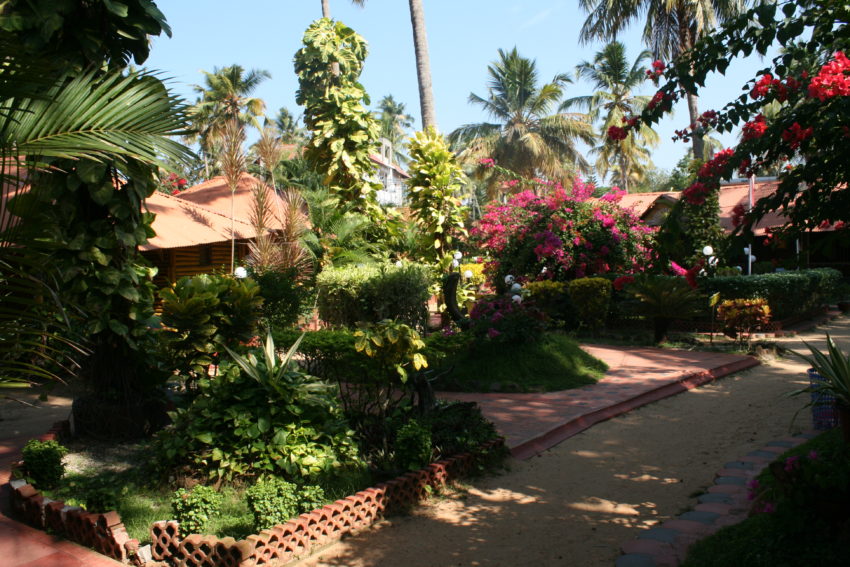
It turns out, the taxi was worth every rupee. The hour-long cab ride was a cheap trip through tropical bliss. We skirted along the southwest coast and three or four times passed entire forests of palm trees, so perfectly swaying in the wind it looked like a scene from “South Pacific.” Even the rivers that flowed into the Indian Ocean looked drinkable.
We also passed the India that people growing up knowing and fearing. As I got in the cab, an old cripple, his withered deformed legs looking like drumsticks curled under him on his wheelchair, asked for money.
“Speak English?” he asked.
I didn’t answer. The last time I gave money was in Bali in 1994 at 4 a.m. when I walked out of a bar, giddy with a drink in one hand and a leggy Irish PR woman in the other. Within 30 seconds, a dozen beggars came out of homes, bars and seemingly palm trees to pull on my clothes asking for equal distribution. I do NOT give money to beggars. Giving money to beggars continues the cycle of poverty. Women in Thailand bind their children’s feet to deform them for more pull on tourists’ heartstrings. When you give that woman money, you just bind the next child’s feet a little tighter. Even human rights organizations are against giving beggars money. This is a philosophy I’ll cling to as I descend into the depths of a country with some of the most teeming poverty in the world.
The taxi driver was an old man. Scratch that. He looked old. In India, people look older than they really are. His mouth had two jagged rows of teeth that looked like a treeline after a forest fire. He talked out of an opening between the teeth on the left side of his mouth. He spoke a little English but the words coming out were indecipherable. He pointed out some huge Hindu temples, one with, strangely, a Ferris wheel. I also saw a Baptist church. Red signs bearing the hammer and sickle were everywhere.
“Communist Party,” Random Tooth said. “Thraiualdk klkalla kllla kizzl.” Or something like that.
Random Tooth, for some reason, took back roads all the way to Varkala. I wondered if there was no highway that went up Kerala’s 265-mile coastline or he wanted to give me the scenic route. I did see the typical India signs of back roads lined with garbage, makeshift vegetable markets with women in bright saris strolling around like gumballs. I saw a goat tethered to a cheap food stall. A one-legged man hobbled by us on cheap wooden crutches.
I hadn’t seen a white person the entire hour drive. Then we took a couple of left-hand turns and I found myself in the middle of Pismo Beach, Calif. The alleys were lined chock-a-block with little inns, all uniquely designed with one thing in common: cheap accommodations for backpackers.
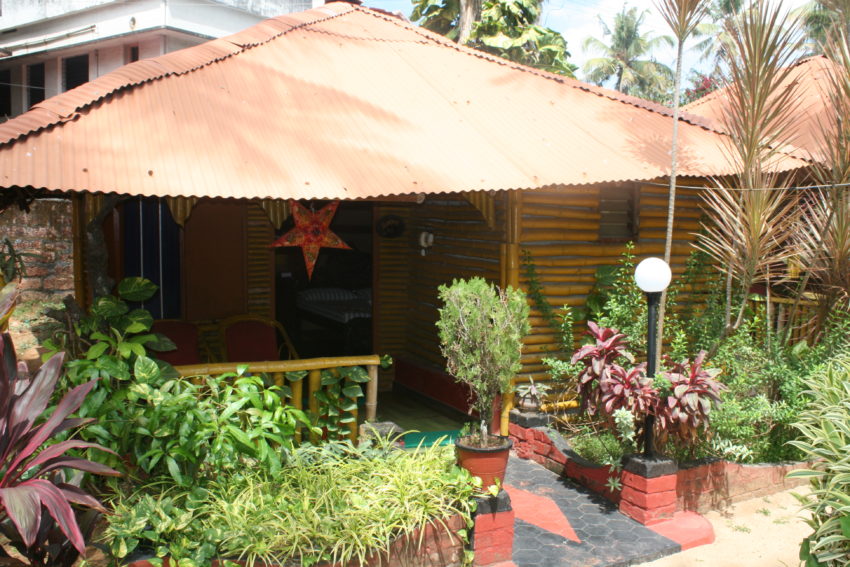
When we reached Kerala Bamboo House, my eyes popped open as if he’d dropped me off at a Club Med property without tourists. Kerala Bamboo Club is a compound made up of large bamboo huts, connected by cute little dirt paths and an absolutely beautiful garden. As I write this on a comfy, cushioned rattan chair on my little porch, I see four huge trees covered in bright pink flowers. Big leafy maroon plants crawl up a lamp post. Palm trees hover over the entire ground like statuesque models. On a loudspeaker somewhere I hear the soft voice of a woman singing a Hindu prayer. Birds sing as they fly past palm trees with the sun coming up beyond them.
My mouth was agape. It stayed that way when I walked past the office 30 feet away. There I stood atop a cliff a good two miles long. Below me about 100 feet was one of the widest, cleanest beaches I’ve seen in Asia. It stretched the length of the cliff and was as broad as a cricket ground. It was golden sand without a speck of rock or garbage anywhere. The sea languidly lapped up against the beach.
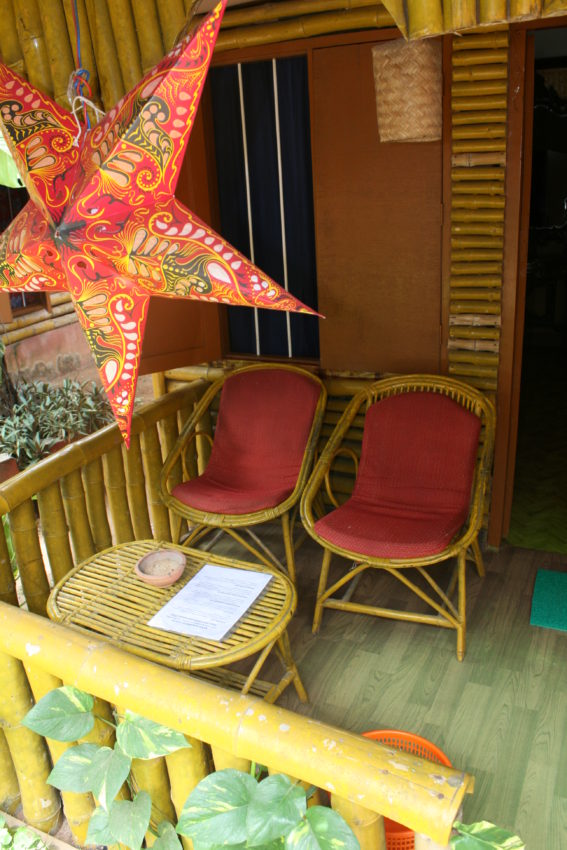
My room is perfect for me: a solo traveler without a life. It’s about 20 square meters with a queen-sized bed and an open shower next to the toilet. A big powerful fan twirls above the bed. I was afraid to ask the cost. With a gorgeous ocean beckoning below, I was in no bargaining position.
One thousand rupees. That’s $16. In Maui this would be $260.
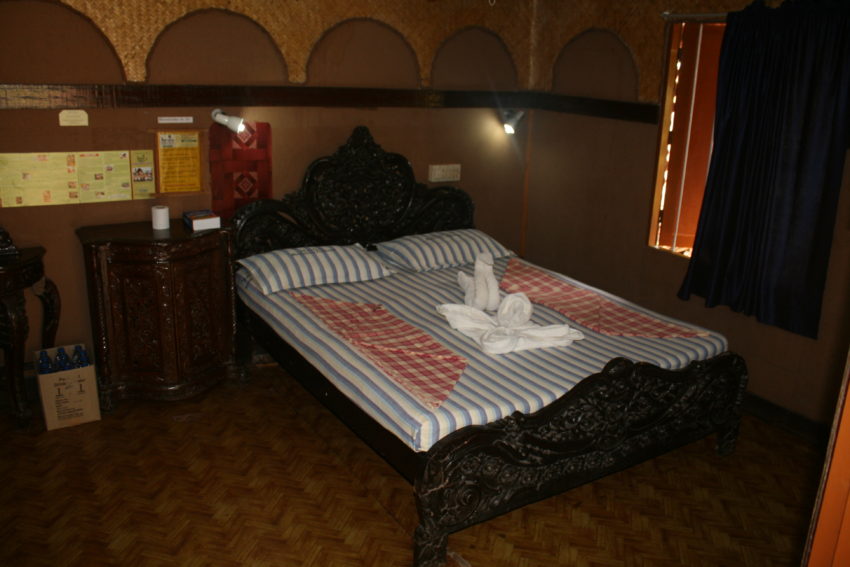
I hung up a few clothes and grabbed some lunch at my new local cafe. The Sun Rise Restaurant would be my home away from home. It’s right next to Bamboo House and has an upstairs floor view of the ocean. The owner is a round-faced, stocky middle-aged Nepali. Song said he didn’t even know the local Malayalam word for thank you (NAN-ee). He came from Kathmandu to make money. If you go to India to make money tells you two things: One, India’s booming economy is no myth; two, wherever you came from was probably really destitute.
“You can’t make money in Nepal,” he said. “The government changes every eight months. It’s very hard.”
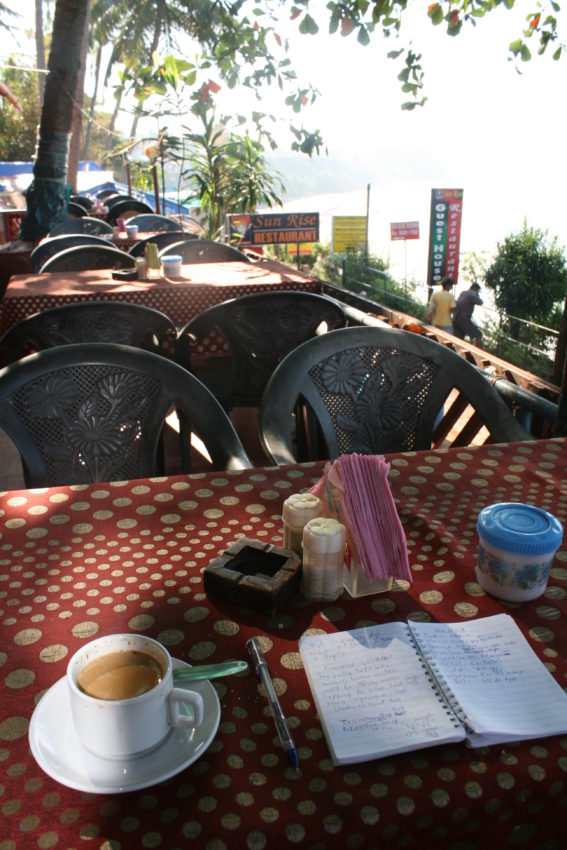
I raced down to the beach after talking to Dunston, the Bamboo House manager who could become my confidant here. He’d better. I’m apparently the only person anywhere in Varkala without some love interest or even a friend. Dunston looks late 40s and his tall demeanor is accentuated by a long, graying beard and long, almost afro, hair. He’d probably pass for a Hindu Rastafarian. But he’s a wealth of information. I asked about the ocean’s safety. Lonely Planet wrote that many strong swimmers have drowned after the currents swept them out to sea.
“You can swim here,” he said. “Just don’t go more than 200 meters. That’s where the currents start.”
The water is as warm as it is in Sri Lanka and much less rough. It’s shallow for about 100 yards and the waves gently rolled over my face as I lay on my back closing my eyes against the sun in a brilliant blue sky. The pollution of urban India is just a rumor here. Kerala tourism has made this beach as appealing as anyplace in the world. Just half a kilometer from garbage-strewn streets and who knows how many rats, I sat on a beach that was cleaner than the one near the Santa Monica Pier.
But this is different. I knew I was on an Indian beach when a man and a woman, both with separate partners, were doing yoga poses. One slim woman had bent herself into what looked like a Bavarian pretzel. Her husband/boyfriend was face down in the sand, looking totally spent. Looking at how his lady bent herself into impossible positions, I’m assuming he wasn’t tired from jet lag.
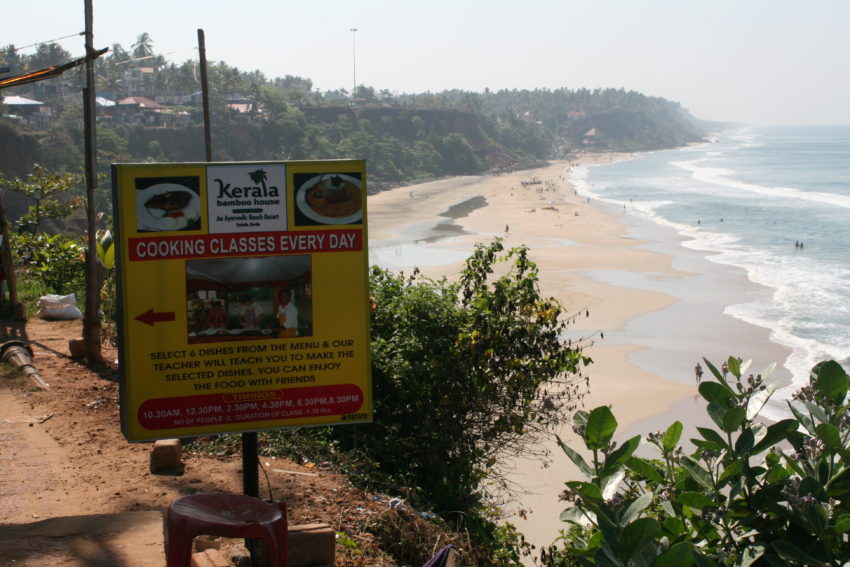
As I sat on the beach reading a beat-up used copy of Tom Clancy’s 1999 novel, “Balance of Power,” I asked myself. Is this the real India? Spotless beaches. Bamboo huts. Palm trees. Then again, what is the real India? India’s size always intimidated me. How do you grasp it? India is the second-most populated country in the world with 1.27 billion people. It’s the most populated democracy. There are 33 people per square kilometer. U.S. has one. And India is massive: 3.3 million square kilometers. If you put it over North America it would stretch from Guadalajara to the American-Canadian border. Besides beaches in Kerala, there are desserts in Rajasthan, mountains in Kashmir, forests in Maharashtra.
The Indian constitution recognizes 24 official languages. There 1,600 minor languages. In Kerala they speak something called Malayalam which sounds like a cross between Hindi and Arabic. They don’t even speak much Hindi down here. So the one Hindi word I know — Namaste — is worthless. I am completely illiterate.
India is 50 different countries tied together by a 60-year-old independent democracy that has survived assassinations, ethnic tensions and a continually tense border with Pakistan which still claims Kashmir belongs to it. Now it is riding the second fastest-growing economy in Asia. It is the world’s new super economic power. Yet the massive disparity of wealthy and poor has grown wider. And the poor are more pissed. Violent crime is up. Gangs are emerging in the inner cities. It is too much for one country which is why India is so many countries.
Last night I wondered what country I was in. I talked to waiters and shopkeepers and noticed half the souvenir stores sold Tibetan handicrafts, jewelry and paintings. Good Lord, the whole cliff side is covered with souvenir stores, all selling the same crap: chunky jewelry looped over white mannequin necks, Kingfisher beer T-shirts, sarongs and saris of every color and print imaginable, rope bracelets, sandals, those ugly Ali Baba pants that look awful anywhere but in an Indian village or Halloween party. Indiaphiles think they make them look like a local — while they sit in cafes and eat omelettes.
And Varkala was dead. Couples dined quietly by candlelight at the dozens of restaurants selling the same insane mix of Indian, Tibetan, Western, Chinese. I even saw Israeli dishes posted on a menu. The Big Apple Cafe had Sinatra blaring from a loudspeaker filling an open-air dance floor populated by just one really bored D.J. I wrote down some notes outside the equally flaccid Rock N’ Roll Cafe (“Eat. Play. Relax,” read the sign in a bastardization of Elizabeth Gilbert’s book, “Eat. Pray. Love.”) and a gay who could change a $9 into threes cooed, “Why are you writing?”
This has gone from paradise to a tourist trap. I don’t regret coming here. One look down the cliff and hearing those waves hit the beach as I’m writing this tells me I found the perfect place to chill. But of all the Indias, I may have found the phoniest.
But I have two weeks in Kerala. I have yoga to try, meditation to contemplate, a cooking class to taste. There are backwater canoe trips, game reserves and homestays. I don’t know if Varkala is the real India but, as they say in meditation, what is reality? What is the real India? What is the real Rome? It’s what we make it. If you keep an open mind, even the most plastic of experiences becomes tangible, like a dirty shell that’s polished enough to place on your mantle.
India is overwhelming if you think about it. I’ll take this little corner of it and make it my India.

